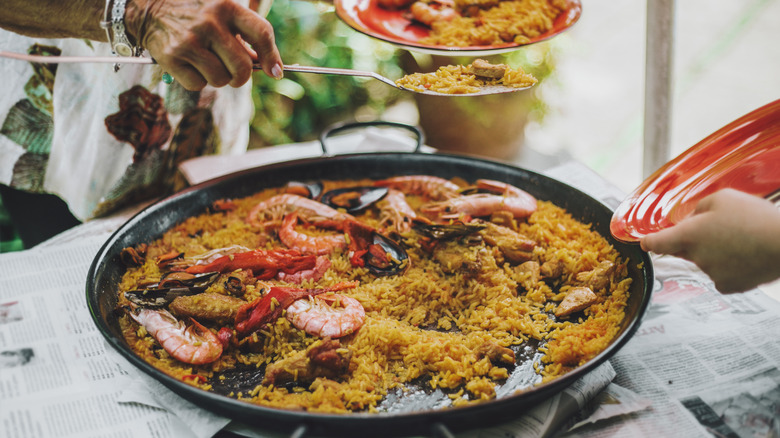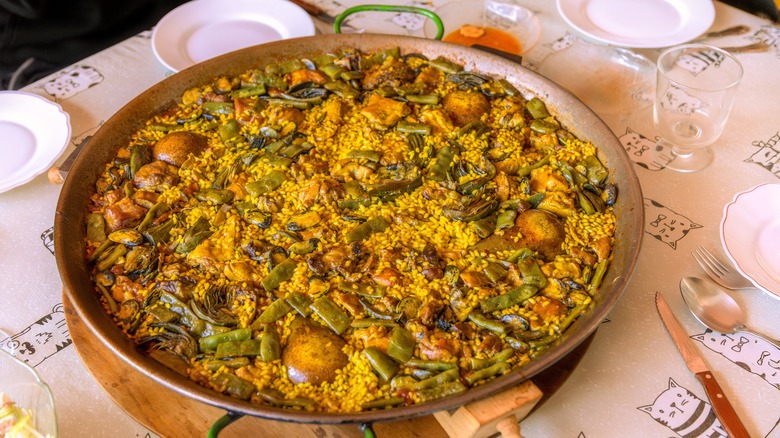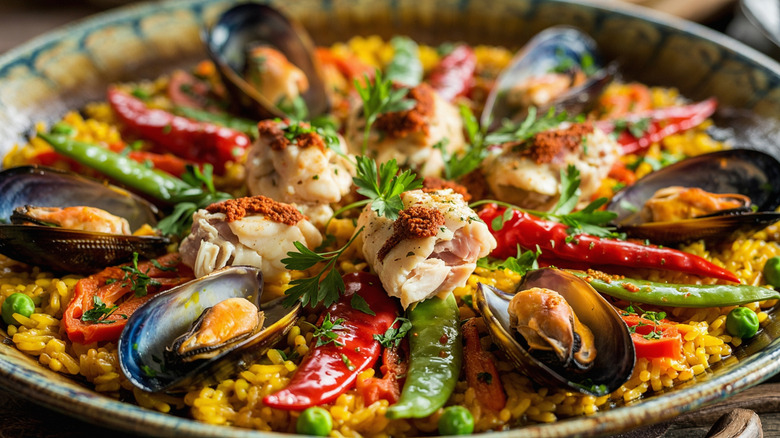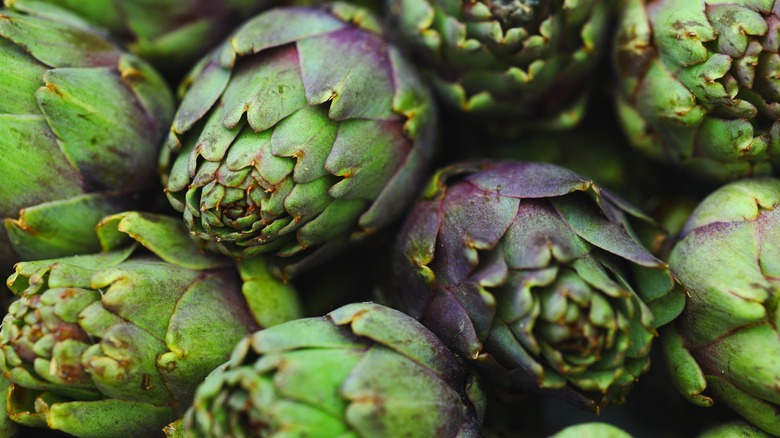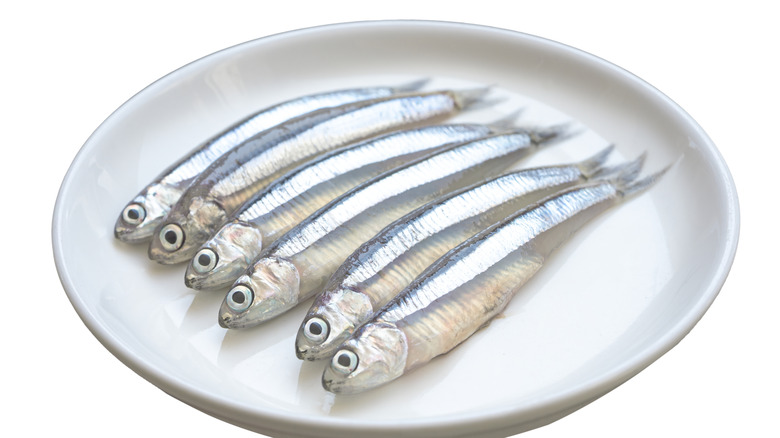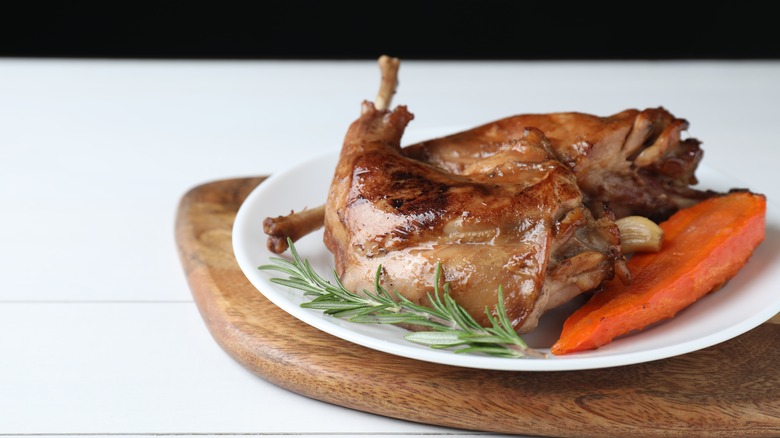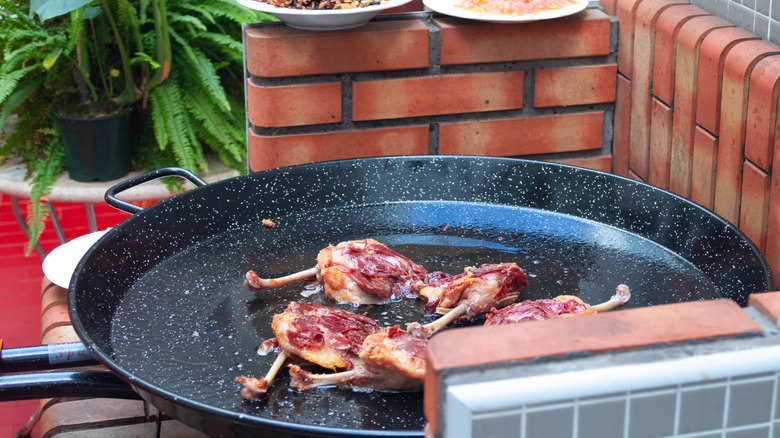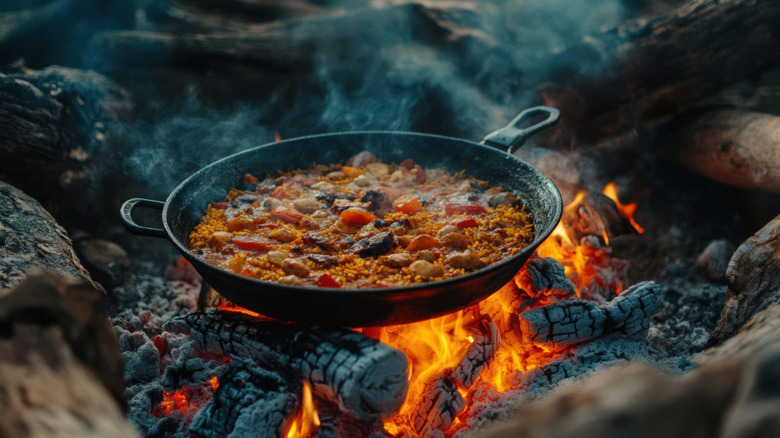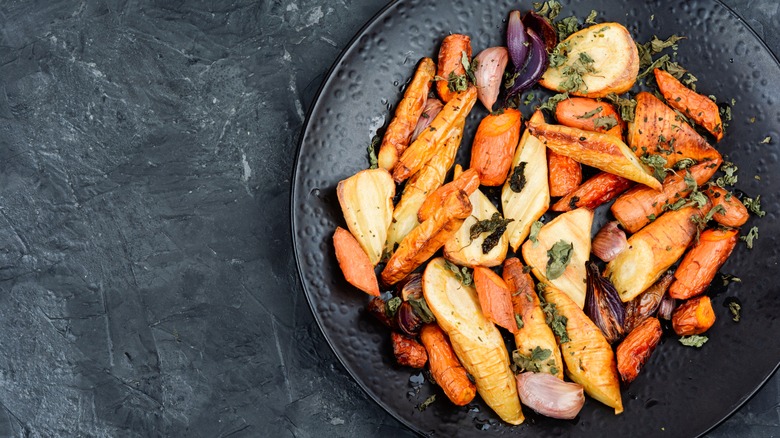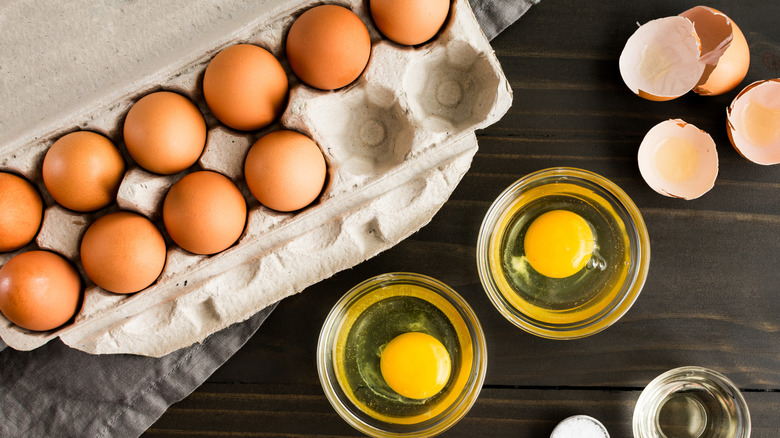Experts Reveal 10 Secret Ingredients You Should Be Using In Your Paella
Most people know the usual paella ingredients well enough, or you should, since it's one of the most influential international dishes — composed of rice, seafood, chorizo, smoked paprika, and, of course, saffron for that distinctive golden color. But there are other ingredients that can transform the dish that are sadly underused. Some of these ingredients have been part of paella's story since the very beginning. They appeared in those first recipes centuries ago in Valencia's countryside, but somehow got overlooked as the dish traveled around the world. Other additions are completely modern innovations; new ideas that complement paella so naturally that they feel like they've always belonged.
Two experts have shared their knowledge of these authentic techniques. Guillermo Bermell owns Paella Lover, a Valencia-based cooking school that specializes in teaching the authentic methods developed in paella's birthplace and brings generations of Valencian cooking wisdom to every lesson. Scott Groth brings a different perspective as a trained chef and author of the blog I'd Rather be a Chef. His professional background includes owning both a cooking school and catering company, with expertise spanning multiple dietary preferences and culinary traditions from keto and vegetarian cooking to traditional old-world techniques. Both of them understand which small additions can transform ordinary paella into something genuinely memorable, and they're not afraid to use ingredients that might surprise anyone expecting the standard tourist version. Some provide depth and richness, others add texture or color, and a few are simply connections back to its authentic roots. This is one Spanish dish you must try.
Green beans
The broad green beans in authentic Valencian paella aren't there by accident — they're a direct connection to the fertile fields surrounding the Albufera de Valencia lagoon where this iconic dish was born. It all started over 1,000 years ago when the Moors swept across the Iberian Peninsula, bringing with them something that would change Spanish cooking forever: rice from the Far East. "And why Valencia?" Guillermo Burmell asks, "because there is an Albufera, which is a sweetwater lagoon, where rice was grown for the first time in Europe around the 8th or 9th century A.D."
Now, the Moors (hailing from North Africa) were rather fond of their elaborate feasts — three salads, three fish, three meats, the whole works. But being practical, they'd take the leftovers and mix them with rice and saffron in a dish called Al Baquiyah — "bahiya" they pronounced it — which many reckon gave paella its name.
The local peasants working those Valencia fields took this idea and made it their own, using "everything they had at hand to cook this dish and enrich it with flavor and vitamins and minerals," explains Guillermo. Those broad beans grew beautifully in Valencia's rich soil. Unlike more delicate vegetables that might collapse into mush, these sturdy pods could handle the long, gentle cooking. When you choose green beans for your paella, you're carrying on a tradition that goes back to the very beginnings of the dish. The farmers from centuries ago chose them because they were abundant, but generations after have kept them because they just work so well.
Monkfish
"If you're looking to create a memorable paella that is more than just a paella mixta, we can find some really nice ingredients that hold up to the longer cooking process and taste delicious," Scott Groth says. "Using a firm, meaty fish like monkfish is a great place to start." Monkfish is one of the best fish to use in seafood paella, also known as paella de marisco, which is a beloved staple across Spain's coastal regions. Guillermo Bermell tells us of the ingredients in his grandmother's recipe for seafood paella, "cuttlefish, squid, monkfish, shrimp, leek, tomato, garlic, rice, oil, sweet red pepper, water, saffron."
Sometimes called the poor man's lobster, monkfish delivers a firm texture with a mild, slightly sweet taste that doesn't overpower the delicate saffron. You should find it at most grocery store fish counters or fishmongers, but cod, halibut, or haddock make excellent substitutions if needed, since you probably shouldn't eat monkfish super regularly.
To prepare monkfish properly, remove any blue or grey membranes, which are harmless but unpleasantly chewy. Then, Groth advises you to chop it into small pieces and sauté "before adding to the paella for maximum flavor." This quick sear develops deeper flavors while ensuring the fish maintains its structure throughout the slow cooking process.
Artichoke
Spring brings fresh artichokes to peak season, and they've been part of Guillermo Bermell's family paella recipes for three generations. These Mediterranean staples might look intimidating with their layered leaves, but they're worth the effort for the tender heart inside. Artichokes work perfectly in paella because they hold their shape during the long cooking process. Unlike delicate vegetables that fall apart, artichokes maintain their texture while absorbing all the flavors from the rice and saffron. They're substantial enough to anchor vegetarian paellas and complement both spring vegetables and meat dishes beautifully.
Fresh artichokes are in season from March through May and can be found at farmers markets and specialty shops. If you can't source fresh ones or prefer to skip the preparation, quality canned or frozen artichoke hearts work perfectly fine. Just remember to add them during the final stages, after the rice has cooked, so that they don't completely disintegrate.
To prepare fresh artichokes, add lemon juice to a bowl of cold water and set aside. Trim the stalks, tear off the tough outer leaves and base leaves until the yellow-green center appears. Use a teaspoon to scoop out the fibrous choke in the center, cut into chunks, then immediately submerge in the lemon water to prevent browning until you're ready to add them to your paella.
Rosemary
Walking through the hills around Valencia, you'll see wild rosemary bushes everywhere, with their needle-like leaves releasing that distinctive piney fragrance in the Mediterranean heat. Guillermo Bermell's family certainly has been adding it to their paella for three generations. There's a lovely story behind the connection with rosemary that goes back to the old days when snails were a common paella ingredient. The locals would feed their snails on rosemary for days before cooking them, so the little creatures arrived at the pan already perfumed with herbs. Quite ingenious, really, though if you don't feel like setting up a snail farm in you spare bedroom, a few fresh sprigs will do.
Rosemary's resinous, almost medicinal quality pairs perfectly with saffron's floral notes. The trick, as with most good cooking, is restraint. Rosemary can be a bully if you're not careful — too much and it'll dominate everything else in the pan. Always use fresh sprigs, never dried. Dried rosemary has a higher concentration of oils and the flavor will be too intense. Simply lay a whole sprig on top of the rice during the final 10 minutes of cooking. The gentle heat will coax out just enough of those volatile oils to perfume the dish without overwhelming it. Then, fish it out before serving — job done.
Anchovy paste
The secret to any great paella lies in something the Spanish call sofrito — a slowly cooked base of onions, garlic, tomatoes, and olive oil that forms the flavor foundation of the dish. Scott Groth rightly compares it to a French mirepoix or the Cajun holy trinity. "The secret is to keep things slow and low, never rushing the process," Scott explains. "The sofrito sets the stage for everything to come in the paella, giving it depth and umami." Guillermo Bermell describes Ferran Adrià's (one of the world's greatest chefs) sofrito recipe: "300 grams of onion, two spoonfuls of crushed canned tomato, one clove of garlic, a pinch of salt, dried thyme and rosemary, a quarter of a bay leaf, all cooked slowly in olive oil."
But here's where Groth reveals a professional secret that's rather brilliant, "At my cooking school, we would make the sofrito with a touch of smoked paprika, just a dab of anchovy paste (it adds amazing depth and nobody ever knows it's been added) and a touch of lemon zest to brighten things up just a bit." Along with smoked paprika and lemon zest, this tiny addition transforms the dish.
What anchovies excel at is delivering umami — that mysterious fifth taste that food scientists only properly identified in the 1980s. Before then, the Western palate recognized just four flavors: sweet, salty, bitter, and sour. Umami is rather difficult to describe, but think of that rich, deep, almost meaty satisfaction you get from a perfectly grilled steak, earthy mushrooms, or Japanese miso. That savory sensation comes from natural glutamates, and the underrated anchovy happens to contain more of these flavor compounds than almost any other ingredient.
Rabbit
Rabbit was one of the original ingredients in authentic Valencian paella. While it might seem an unusual choice to modern palates, Scott Groth reminds us that rabbit provided abundant, easily sourced protein for the peasants working Valencia's Albufera rice fields centuries ago. The flavor sits rather nicely between chicken and lamb. It's a lean meat that Groth describes as "rich, earthy and completely satisfying."
While rabbit isn't quite the easily-sourced protein it once was for those Valencia field workers, modern cooks can find quality rabbit through online specialty suppliers without too much trouble. The cooking process is straightforward. Brown the rabbit pieces at the very beginning, then lift them out while you prepare the sofrito. Once the sofrito has developed properly, return the rabbit to the pan along with the rice and stock. From there, everything cooks together for those crucial twenty to twenty-five minutes, allowing the rabbit to become tender while flavoring the entire dish.
Duck
Duck adds real depth to paella that's hard to achieve with other meats. Its naturally high fat content and bold flavor bring a richness that transforms the dish. By browning the duck pieces first, you then use that lovely rendered fat for cooking the sofrito.
Scott Groth found his perfect duck paella on a trip to southern Valencia, a "paella de pato" featuring duck, artichokes, and mushrooms. He remembers the timing well, "as the season was transitioning from fall into winter," and what elevated it beyond the ordinary was the fresh foie gras served alongside. Guillermo Burmell's recommendation is duck magret paella with foie gras, tender garlic and shiitake mushrooms. Shiitake mushrooms are a clever addition — bringing a meaty umami depth that complements duck beautifully.
This style of paella moves well beyond everyday cooking into something special. The duck fat enriches every grain of rice, while the meat itself provides substance and character that lighter proteins simply cannot match. It's paella elevated to restaurant quality, the kind of dish that lingers in memory long after the meal ends.
Wood smoke
Smoked paprika appears in most paella recipes these days, and one might assume it was always part of authentic Valencian cooking. Surprisingly, it wasn't among the original ingredients. But something else was — the natural smoke flavor from open fires. Scott Groth explains that paella "was cooked over open fires because the field workers didn't have access to stoves. They used wide pans as it allowed for even cooking and also everyone could eat directly from the pan, making this dish naturally communal since its origin." Guillermo Bermell also give us hints to this connection. Among the ingredients his family has used for three generations, he mentions sweet paprika, but specifies "smoked if not cooking with wood." That little detail reveals everything about authentic paella cooking.
So why not embrace the truly authentic method and cook over an open flame? It creates such a memorable experience that guests will talk about it for years. The delicious aromas of burning wood mingling with the paella, the visual drama of a proper paella pan over dancing flames, and then everyone sharing from the same dish — it's cooking theater at its finest.
The process sounds more challenging than it actually is. Any back garden can accommodate this adventure, and it's equally brilliant for camping trips. Use an existing grill, create a makeshift fire pit, or construct something simple with cinder blocks and a grill grate. You can buy cast iron tripods specifically for this purpose, sitting about thirty centimetres off the ground at just the right width to support a paella pan.
Root vegetables
Root vegetables might not spring to mind when thinking about paella, but they have a lovely way of adding substance and character to the dish. "Sometimes it's nice to add in a bit of change to traditional recipes," Scott Groth explains. "Roasted carrots or parsnips would be delicious in a fall or winter paella, adding more robust flavors and earthiness."
There's actually precedent for this in Valencia itself. Guillermo Bermell describes a regional dish called paella with beans and turnip, which takes quite a different approach from the standard method. "This is another way of cooking rice that is only known in Valencia, with lots of broth — the rice is literally swimming in the broth," he explains. The combination includes blood sausage, pig's face, ears and hands, beans, and turnip. It's a hearty, almost stew-like preparation that shows how flexible paella can be.
For something rather striking, Guillermo suggests adding beetroot for its dramatic color. The result is quite wonderful — paella with this lovely pink hue and that distinctive earthy sweetness that beetroot does so well.
Beaten eggs
Beaten eggs might seem like an odd addition to paella, but in one corner of Valencia, they've been creating something quite special with this humble ingredient. Paella con costra comes from a small region in Alicante, and it's one of those wonderful examples of how Spanish cooks developed their own interesting local variations.
The dish itself follows traditional lines with rabbit, chicken or turkey, rice, white blood sausage, and red and white sausage. When it comes to the sausages, Guillermo Burmell explains that cooks use "various types to give a more intense flavor, but never spicy," along with the usual water, olive oil, saffron, and salt. So far, so familiar.
But here's where it gets interesting. The paella cooks exactly like a standard Valencian version until near the end. Then, about 10 minutes before the rice is ready, beaten eggs get spooned over the entire surface. The whole pan goes into the oven, where the eggs set and create what Guillermo calls "this layer of crunchy eggs." The result is rather brilliant, really. That golden egg crust provides a completely different texture on top while the rice underneath remains perfectly tender. It's the sort of practical innovation that rural cooks excel at — taking readily available ingredients and finding new ways to make familiar dishes more interesting.

